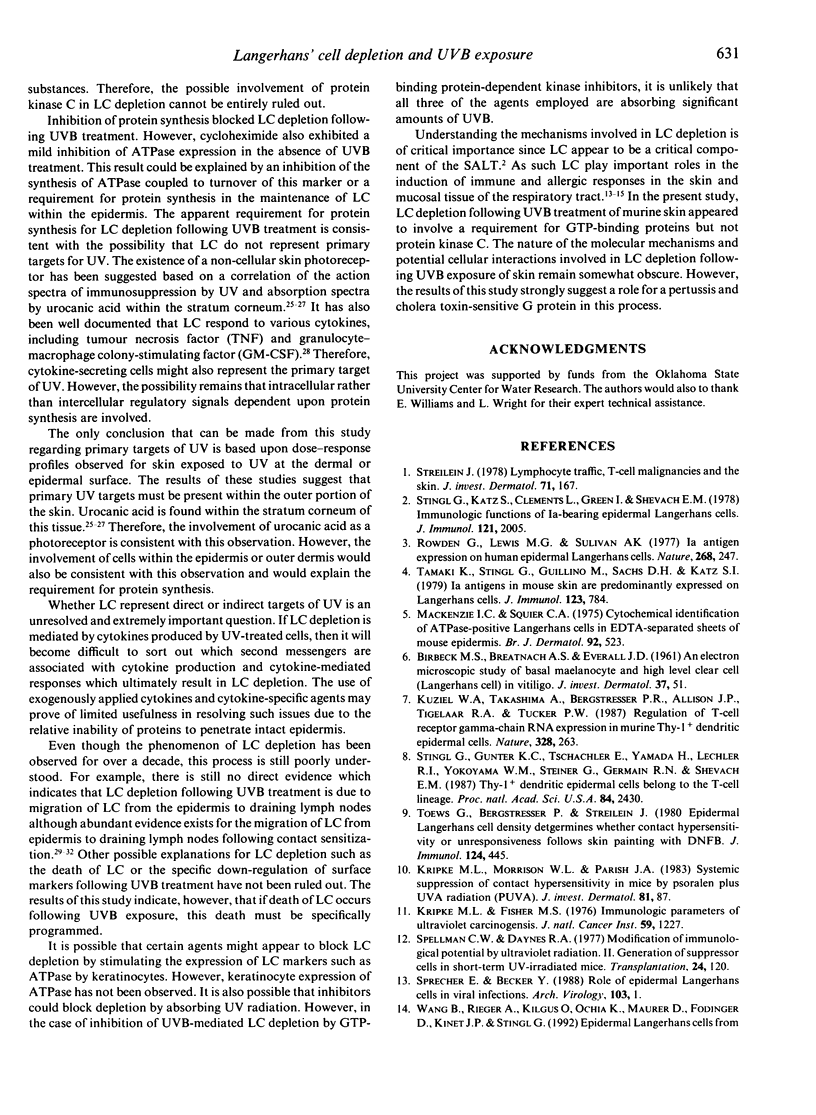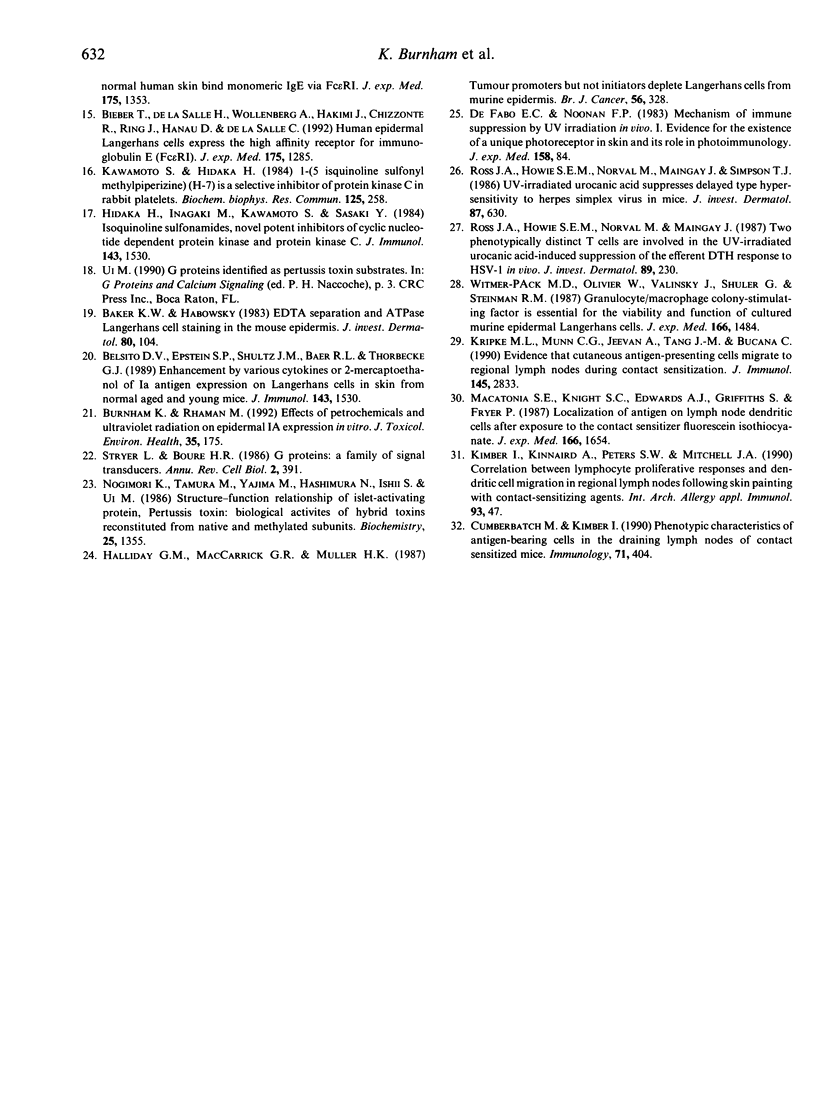Abstract
Langerhans' cells found within the skin and mucous membranes are critical regulators of antimicrobial and allergic responses. Therefore, the depletion of these cells following exposure of skin to solar ultraviolet radiation (UV) has direct functional consequences on immunity within this tissue. In order to understand how Langerhans' cell depletion is regulated following exposure of skin to medium-wave UV (UVB), the role of second messengers in these responses was investigated using a novel in vitro system. This was accomplished by analysing the expression of a specific marker associated with Langerhans' cells (ATPase) among the epidermal portion of cultured sections of mouse skin following treatment with inhibitors specific for second messenger components and subsequent exposure to UVB. In this study, inhibitors of guanosine triphosphate (GTP) binding proteins, H-8, pertussis toxin and cholera toxin as well as inhibitors of RNA and protein synthesis were all capable of blocking Langerhans' cell depletion in response to UVB treatment. In contrast, an inhibitor of protein kinase C (H-7) was incapable of specifically blocking depletion following treatment with this physical agent. These results suggest that Langerhans' cell depletion mediated by UVB may involve a pertussis and cholera toxin-sensitive G protein as well as de novo protein synthesis.
Full text
PDF





Selected References
These references are in PubMed. This may not be the complete list of references from this article.
- Baker K. W., Habowsky J. E. EDTA separation and ATPase Langerhans cell staining in the mouse epidermis. J Invest Dermatol. 1983 Feb;80(2):104–107. doi: 10.1111/1523-1747.ep12531712. [DOI] [PubMed] [Google Scholar]
- Belsito D. V., Epstein S. P., Schultz J. M., Baer R. L., Thorbecke G. J. Enhancement by various cytokines or 2-beta-mercaptoethanol of Ia antigen expression on Langerhans cells in skin from normal aged and young mice. Effect of cyclosporine A. J Immunol. 1989 Sep 1;143(5):1530–1536. [PubMed] [Google Scholar]
- Bieber T., de la Salle H., Wollenberg A., Hakimi J., Chizzonite R., Ring J., Hanau D., de la Salle C. Human epidermal Langerhans cells express the high affinity receptor for immunoglobulin E (Fc epsilon RI). J Exp Med. 1992 May 1;175(5):1285–1290. doi: 10.1084/jem.175.5.1285. [DOI] [PMC free article] [PubMed] [Google Scholar]
- Burnham K., Rahman M. Effects of petrochemicals and ultraviolet radiation on epidermal IA expression in vitro. J Toxicol Environ Health. 1992 Mar;35(3):175–185. doi: 10.1080/15287399209531607. [DOI] [PubMed] [Google Scholar]
- Cumberbatch M., Kimber I. Phenotypic characteristics of antigen-bearing cells in the draining lymph nodes of contact sensitized mice. Immunology. 1990 Nov;71(3):404–410. [PMC free article] [PubMed] [Google Scholar]
- De Fabo E. C., Noonan F. P. Mechanism of immune suppression by ultraviolet irradiation in vivo. I. Evidence for the existence of a unique photoreceptor in skin and its role in photoimmunology. J Exp Med. 1983 Jul 1;158(1):84–98. doi: 10.1084/jem.158.1.84. [DOI] [PMC free article] [PubMed] [Google Scholar]
- Halliday G. M., MacCarrick G. R., Muller H. K. Tumour promoters but not initiators deplete Langerhans cells from murine epidermis. Br J Cancer. 1987 Sep;56(3):328–330. doi: 10.1038/bjc.1987.198. [DOI] [PMC free article] [PubMed] [Google Scholar]
- Kawamoto S., Hidaka H. 1-(5-Isoquinolinesulfonyl)-2-methylpiperazine (H-7) is a selective inhibitor of protein kinase C in rabbit platelets. Biochem Biophys Res Commun. 1984 Nov 30;125(1):258–264. doi: 10.1016/s0006-291x(84)80362-9. [DOI] [PubMed] [Google Scholar]
- Kimber I., Kinnaird A., Peters S. W., Mitchell J. A. Correlation between lymphocyte proliferative responses and dendritic cell migration in regional lymph nodes following skin painting with contact-sensitizing agents. Int Arch Allergy Appl Immunol. 1990;93(1):47–53. doi: 10.1159/000235278. [DOI] [PubMed] [Google Scholar]
- Kripke M. L., Lofgreen J. S., Beard J., Jessup J. M., Fisher M. S. In vivo immune responses of mice during carcinogenesis by ultraviolet irradiation. J Natl Cancer Inst. 1977 Oct;59(4):1227–1230. doi: 10.1093/jnci/59.4.1227. [DOI] [PubMed] [Google Scholar]
- Kripke M. L., Morison W. L., Parrish J. A. Systemic suppression of contact hypersensitivity in mice by psoralen plus UVA radiation (PUVA). J Invest Dermatol. 1983 Aug;81(2):87–92. doi: 10.1111/1523-1747.ep12542071. [DOI] [PubMed] [Google Scholar]
- Kripke M. L., Munn C. G., Jeevan A., Tang J. M., Bucana C. Evidence that cutaneous antigen-presenting cells migrate to regional lymph nodes during contact sensitization. J Immunol. 1990 Nov 1;145(9):2833–2838. [PubMed] [Google Scholar]
- Kuziel W. A., Takashima A., Bonyhadi M., Bergstresser P. R., Allison J. P., Tigelaar R. E., Tucker P. W. Regulation of T-cell receptor gamma-chain RNA expression in murine Thy-1+ dendritic epidermal cells. Nature. 1987 Jul 16;328(6127):263–266. doi: 10.1038/328263a0. [DOI] [PubMed] [Google Scholar]
- Macatonia S. E., Knight S. C., Edwards A. J., Griffiths S., Fryer P. Localization of antigen on lymph node dendritic cells after exposure to the contact sensitizer fluorescein isothiocyanate. Functional and morphological studies. J Exp Med. 1987 Dec 1;166(6):1654–1667. doi: 10.1084/jem.166.6.1654. [DOI] [PMC free article] [PubMed] [Google Scholar]
- Mackenzie I. C., Squier C. A. Cytochemical identification of ATPase-positive langerhans cells in EDTA-separated sheets of mouse epidermis. Br J Dermatol. 1975 May;92(5):523–533. doi: 10.1111/j.1365-2133.1975.tb03120.x. [DOI] [PubMed] [Google Scholar]
- Nogimori K., Tamura M., Yajima M., Hashimura N., Ishii S., Ui M. Structure-function relationship of islet-activating protein, pertussis toxin: biological activities of hybrid toxins reconstituted from native and methylated subunits. Biochemistry. 1986 Mar 25;25(6):1355–1363. doi: 10.1021/bi00354a025. [DOI] [PubMed] [Google Scholar]
- Ross J. A., Howie S. E., Norval M., Maingay J., Simpson T. J. Ultraviolet-irradiated urocanic acid suppresses delayed-type hypersensitivity to herpes simplex virus in mice. J Invest Dermatol. 1986 Nov;87(5):630–633. doi: 10.1111/1523-1747.ep12456257. [DOI] [PubMed] [Google Scholar]
- Ross J. A., Howie S. E., Norval M., Maingay J. Two phenotypically distinct T cells are involved in ultraviolet-irradiated urocanic acid-induced suppression of the efferent delayed-type hypersensitivity response to herpes simplex virus, type 1 in vivo. J Invest Dermatol. 1987 Sep;89(3):230–233. doi: 10.1111/1523-1747.ep12470977. [DOI] [PubMed] [Google Scholar]
- Rowden G., Lewis M. G., Sullivan A. K. Ia antigen expression on human epidermal Langerhans cells. Nature. 1977 Jul 21;268(5617):247–248. doi: 10.1038/268247a0. [DOI] [PubMed] [Google Scholar]
- Spellman C. W., Daynes R. A. Modification of immunological potential by ultraviolet radiation. II. Generation of suppressor cells in short-term UV-irradiated mice. Transplantation. 1977 Aug;24(2):120–126. doi: 10.1097/00007890-197708000-00005. [DOI] [PubMed] [Google Scholar]
- Sprecher E., Becker Y. Role of epidermal Langerhans cells in viral infections. Arch Virol. 1988;103(1-2):1–14. doi: 10.1007/BF01319804. [DOI] [PubMed] [Google Scholar]
- Stingl G., Gunter K. C., Tschachler E., Yamada H., Lechler R. I., Yokoyama W. M., Steiner G., Germain R. N., Shevach E. M. Thy-1+ dendritic epidermal cells belong to the T-cell lineage. Proc Natl Acad Sci U S A. 1987 Apr;84(8):2430–2434. doi: 10.1073/pnas.84.8.2430. [DOI] [PMC free article] [PubMed] [Google Scholar]
- Stingl G., Katz S. I., Clement L., Green I., Shevach E. M. Immunologic functions of Ia-bearing epidermal Langerhans cells. J Immunol. 1978 Nov;121(5):2005–2013. [PubMed] [Google Scholar]
- Streilein J. W. Lymphocyte traffic, T-cell malignancies and the skin. J Invest Dermatol. 1978 Sep;71(3):167–171. doi: 10.1111/1523-1747.ep12547071. [DOI] [PubMed] [Google Scholar]
- Stryer L., Bourne H. R. G proteins: a family of signal transducers. Annu Rev Cell Biol. 1986;2:391–419. doi: 10.1146/annurev.cb.02.110186.002135. [DOI] [PubMed] [Google Scholar]
- Tamaki K., Stingl G., Gullino M., Sachs D. H., Katz S. I. Ia antigens in mouse skin are predominantly expressed on Langerhans cells. J Immunol. 1979 Aug;123(2):784–787. [PubMed] [Google Scholar]
- Toews G. B., Bergstresser P. R., Streilein J. W. Epidermal Langerhans cell density determines whether contact hypersensitivity or unresponsiveness follows skin painting with DNFB. J Immunol. 1980 Jan;124(1):445–453. [PubMed] [Google Scholar]
- Witmer-Pack M. D., Olivier W., Valinsky J., Schuler G., Steinman R. M. Granulocyte/macrophage colony-stimulating factor is essential for the viability and function of cultured murine epidermal Langerhans cells. J Exp Med. 1987 Nov 1;166(5):1484–1498. doi: 10.1084/jem.166.5.1484. [DOI] [PMC free article] [PubMed] [Google Scholar]


